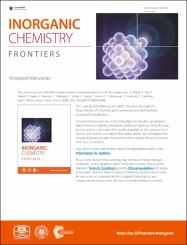A Ni(II) dinuclear complex bridged by end-on azide-N and phenolate-O atoms: spectral interpretation, magnetism and biological study

View/
Access
info:eu-repo/semantics/openAccessDate
2015Author
Daş, KuheliDatta, Amitabha
Nandi, Soumendranath
Mane, Sandeep B.
Mondal, Sudipa
Massera, Chiara
Akitsu, Takashiro
Metadata
Show full item recordAbstract
A potential tetradentate monoanionic N2O2 chelator, HL, derived from the condensation of o-vanillin and N,N-dimethylethylenediammine, has been reacted with nickel perchlorate and sodium azide to yield the dinuclear Ni(II) complex [Ni(L)(mu(1,1)-N-3)Ni(L)(OH2)(2)]center dot ClO4 (1), where L = Me2N(CH2)(2)N=CH-C6H3(O-)-(OCH3). The complex has been characterized by X-ray diffraction analysis and different spectroscopic techniques. The coordination geometry around the Ni(II) centres is a distorted octahedron, with the azide ligand and the phenolato oxygen atom bridging in mu(1,1) and mu(2) mode, respectively. The EPR spectra, recorded at liquid nitrogen temperature (77 K) and room temperature (298 K), show g factors of 2.080 and 2.085, in agreement with the structure determined by X-ray diffraction analysis. The VTM study confirms that there are ferromagnetic interactions between the bridging binuclear Ni(II) ions (S = 1). The evaluation of cytotoxic effects on different human cancer cell lines (A-549, MCF-7 and CaCo-2) suggests that both the ligand and complex 1 have potential anticancer properties. Furthermore, they also exhibit anti-mycobacterial activity against M. tuberculosis H37Rv (ATCC 27294) and M. tuberculosis H37Ra (ATCC 25177) strains. Molecular docking of HL with the enoyl acyl carrier protein reductase of M. tuberculosis H37R(v) (PDB ID: 4U0K) has been examined, showing that HL forms two hydrogen bonds with Lys165 (1.94 and 2.53 angstrom) in its best docked pose.

















